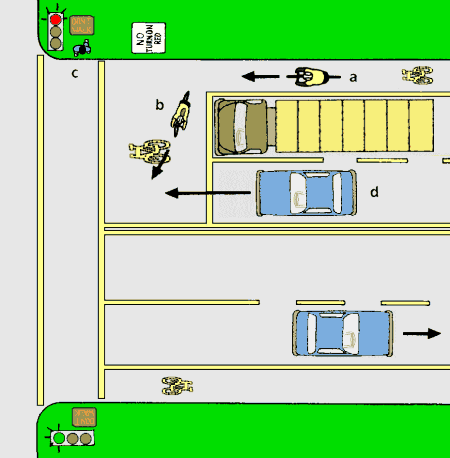Let me put it as simply as I can about bike boxes.
To do that, I’ll make a comparison. Let’s first consider a signalized intersection, and focus on the crosswalk.
Pedestrians enter the crosswalk from the sidewalk. At either end of the crosswalk is a ped-head signal timed to give pedestrians time to cross before conflicting traffic gets the green light. Pedestrians can see the ped head and choose whether to start crossing. They can see the waiting vehicles in every lane.
Also, pedestrians can stop on a dime, and can step back or sideways. Upon reaching the far side of one lane, they can easily look back along the next lane to see whether a vehicle is approaching. (Even so, one common pedestrian crash type is the “multiple threat” collision in which a pedestrian walks or runs out from concealment by one vehicle into the path of another in the next lane).
Now let’s consider the bike box, (the common kind, which I call an “in-line” bike box — as shown in the image below; also see my definitions on another Web page). This image shows conditions immediately after the traffic signal has changed to “don’t walk” for the crosswalk, red for the cross street and green for the street with the bike box.

Bicyclist (a) is approaching the bike box in a bike lane, coming from behind and to the right of waiting motor vehicles. But unlike pedestrian (c), bicyclist (a) gets no warning as to when the traffic signal will change. Bicyclist (a) is at risk of going under the wheels of the first vehicle waiting in line if it turns right.
The “don’t walk” indication for the crosswalk provides plenty of warning to pedestrian (c). But bicyclist (b) gets to see the ped head only after having turned left past the right front corner of the waiting truck — already directly in front of it.
To avoid colliding with bicyclist (b), the driver of the truck has to look into his right-side rear-view mirror, and neither too early or too late. The truck driver’s increased task burden also increases the likelihood of a mistake in negotiating with other traffic ahead in the intersection.
Some trucks and buses have a high hood so the driver can’t see a bicyclist close in front. The problem of pedestrians in crosswalks being struck by vehicles with high hoods is well-known. Expect the same with bicyclists in bike boxes.
These problems can occur with a bike box only one lane wide. But if the bike box is two or more lanes wide, as shown here, a waiting vehicle such as the truck may completely hide bicyclist (b) from the driver of car (d), which hasn’t reached the intersection yet. The driver of car (d) has seen the light change to green and is accelerating. Bicyclist (b) is, then, at risk for the classic “multiple threat” collision. like a pedestrian in the crosswalk after the signal has changed. But a bicycle is several feet long broadside to the traffic, and unable to stop as quickly as a pedestrian, or to sidestep or step back.
It goes without saying that right turns on red must be prohibited at a bike box, but even so, I can’t figure out any way to avoid the conflicts I’ve described, other than a special warning signal for the bicyclists. This signal would have to face the bike lane. It would have to be timed so bicyclists can enter the bike box and travel across all the lanes to its far side before the green light. This signal would serve essentially the same purpose as pedestrians’ “don’t walk” signal.
This provision would, to be sure, increase delays at the intersection, and especially for the bicyclists, who would pile up in the bike lane once the warning signal comes on. Bicyclists who must use the bike box to turn left would then get in the way of others who might otherwise be able to continue straight ahead.
Let’s just get it straight: bike boxes as commonly understood and implemented are a “buzzword” facility whose viral popularity is based on misconceptions about safety, and which flies in the face of any common understanding of how to achieve traffic safety. Even more troubling, though bike boxes require high and sometimes superhuman levels of skill of both bicyclists and motorists, they are being installed explicitly to encourage inexperienced, “traffic-intolerant” bicyclists to ride on busy urban streets.
For there to be reasonable safety, signalization must prevent streams of traffic from traveling through the same space at the same time in different directions, or else there must be adequate sight conditions so that people can negotiate right of way with one another. Lacking either of these conditions, the only recourse is for drivers — motorists and bicyclists alike — to operate very slowly and with extreme caution. The bike box is a bastard combination of inadequate signalization with defective sight conditions. The only way it can be made safe without the special signal is for bicyclists and motorists to take extreme and unusual care.
The problems I have described do not occur with any of several other provisions for bicyclists to continue straight or turn left across intersections, including vehicular movements, heavily-engineered signalized sidepaths (see photos of the 9th Avenue sidepath in New York City ); or the two-stage turn queuing box, also described on another Web page.

Thank you for disassembling the naiveté of bike box advocates
That’s interesting. The pedestrian does indeed see the “Do not Walk” but the bicyclist has to make a turn, and while he makes the turn, he doesn’t see the traffic light…
That’s risky but I guess you just have to be cautious
Pingback: About the Austin, Texas bike box study | John S. Allen's Bicycle Blog
Pingback: The Advanced Stop Line or "Bike Box" - Beezodog's Place